31 Dec 2019
Key CPD events often come highly recommended – particularly if they feature top-notch lectures in fabulous European cities. Andrew Peffers, BVetMed, CertAVP(Ed), BAEDT, MRCVS, provides an overview of the equine dental programme at this year's congress in the Netherlands.

A pony with severe odontoclastic tooth resorption and hypercementosis of incisors 101, 201 and 202.
I was fortunate to be able to again visit the European Veterinary Dental Forum (EVDF), which this year was hosted in Utrecht, the Netherlands.
The EVDF is always a fantastic, well-organised congress with outstanding speakers, and is held in some of the best cities in Europe. Several lecture streams were on offer, including sessions on general small animal dentistry, advanced small animal dentistry and equine dentistry, as well as lectures for VNs. I attended for the equine dentistry, and in this article I will give a brief overview of the two days of lectures.
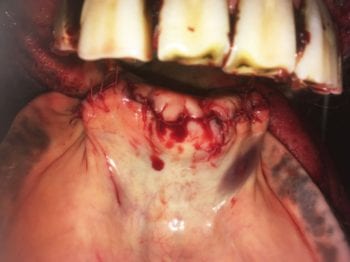
Neil Townsend’s lecture was on radiographic and CT interpretation. We were reminded that, for accurate diagnosis using radiography, it was essential to use multiple views. These are the lateral view, dorsoventral view, the latero-30° dorsal-lateroventral view for maxillary cheek teeth and the latero-45° ventral-laterodorsal view for mandibular cheek teeth. Care must be taken to avoid rostral-caudal angulation, as this can make the radiographs of undiagnostic quality. Dr Townsend reiterated that the most-reliable signs for diagnosis of apical infection on radiographs are periapical sclerosis and periapical halo formation.
Padraic Dixon presented a review of imaging, and gross and histological findings in clinically normal and diseased cheek teeth infundibula. Equine maxillary cheek teeth contain two infundibula. Latest CT studies have shown these infundibula, especially the rostral (mesial) infundibula, to be incompletely filled with cementum. During tooth development and eruption, the blood supply to the caudal infundibulum persists for longer than the blood supply to the rostral infundibulum, which is why the rostral infundibulum is more prone to developmental cemental defects.
CT studies have shown two main patterns of developmental cemental hypoplasia. The first is apical cemental hypoplasia, which involves the whole width of the infundibulum in the more apical portion of the infundibulum. The second is central linear hypoplasia, which usually only involves the central portion of the infundibulum, but across its entire length. This lecture was complemented by a talk on the second day, given by Richard Reardon, on how cheek teeth infundibula can be assessed for cemental hypoplasia/caries.
Kieran Rowley described a study on CT examination of equine cheek teeth sagittal fractures and associated pathology. A total of 87 sagittal fractures from 81 teeth were recorded. In total, 77% of teeth had evidence of apical infection on CT examination and, therefore, warranted treatment. The 77% figure was higher than most congress delegates were expecting, and was a timely reminder that all sagittal fractures should be taken seriously and investigated thoroughly.
A study on occlusal fissures in the equine cheek tooth: μ-CT and histological findings was discussed by Elke Pollaris. Fissures in equine cheek teeth are commonly encountered on oral examination; however, the significance of these fissures is disputed.
Some fissures were significantly bigger than expected, ranging in length from 2mm to 20mm and in depth from 1mm to 24mm. The results demonstrated that fissures may develop from mechanical trauma and that they were deeper on the buccal side of the tooth and on 09 teeth. In addition, the fissures may potentially provide a pathway for micro-organisms to enter the dentine tubules.
Lieven Vlaminck talked about the surgical treatment of sinus mucocele in miniature horse breeds and the long-term follow-up of seven cases. The conclusions were that, following a frontonasal sinusotomy approach and nasomaxillary drainage repair, the long-term outcome was very good in all seven cases.
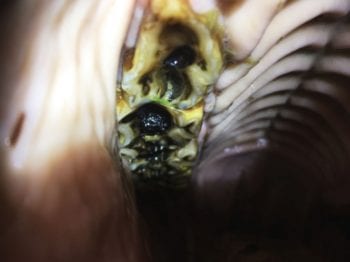
The two lectures to follow dealt with sinusitis. Astrid Bienert-Zeit detailed complications from sinusitis in horses. She divided these complications into two categories. The first category was complications from the sinusitis or primary disease. These included inspissated pus, bony deformities, head shaking and even meningoencephalitis. The second category was complications from the treatment of the sinusitis. These included haemorrhage, suturitis, bone sequestra and fistula formation, and damage to the lacrimal duct and infraorbital canal.
The conclusion of this lecture was complications associated with sinusitis and its treatment were very common; however, as long as the underlying condition has been treated appropriately, these can usually be cured. The prognosis is poor if the horse develops neurological symptoms or if a malignant neoplasia is diagnosed.
Henry Tremaine delivered a lecture on multi-resistant bacterial isolates after sinus empyema. Most cases of sinusitis are treated with doses of broad-spectrum antibiotics based on convenience, rather than culture and sensitivity. Cases that are refractory are often prescribed further antibiotics, with no additional sensitivity testing. Three cases were presented of sinusitis caused by multi-resistant bacteria. The implication of this lecture was culture and sensitivity should be performed, if possible, on every case of sinusitis.
Up next was management of the dental alveolus post-extraction, again presented by Dr Bienert-Zeit. This is a topic us clinicians in dental practice deal with on a weekly basis, and the perfect solution has still not been found. This lecture advised packing the alveolus with a honey-soaked gauze or capping it with dental putty. Dr Bienert-Zeit prefers to pack the alveolus with a gauze, unless she is worried about a communication with the sinuses, in which case she caps the alveolus with dental putty. She also recommended checking the alveolus regularly, preferably once a week, and flushing and cleaning the socket at these checks. Any necrotic material or bony sequestra should be removed immediately.
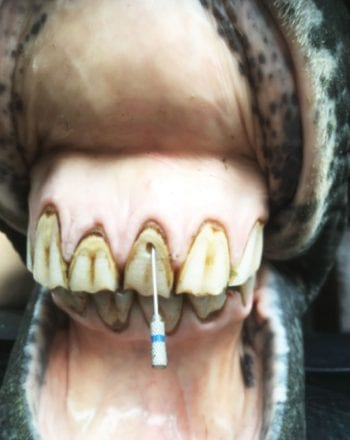
Chris Pearce then presented on the minimally invasive repulsion (MIR) technique in 37 standing sedated horses. The 37 cases happened across a five-year period and accounted for 3.6% of all extractions carried out. All the procedures were undertaken in one surgery, all the tooth fragments were removed and 34 cases out of the 37 had completely resolved by nine months. Dr Pearce concluded that MIR should be considered a safe and effective “last resort” technique for dental extraction when other techniques have been tried and have failed.
A new and brilliant addition to the congress this year was a section where various high-profile clinicians presented cases that had not gone according to plan or where mistakes had been made. As Sir Liam Donaldson said: “To err is human, to cover up is unforgivable, and to fail to learn is inexcusable.” Cases included a horse that had a fractured mandible following an extraction, damage to an adjacent tooth during an extraction and a case of suturitis with a multi-resistant bacteria following sinus surgery. After each presentation, time was set aside for discussion about these cases and everyone learned a lot from this session.
In the evening, one of the highlights of the congress was the official dinner, which this year was held in the rather unusual setting of the Utrecht Organ Museum. While at the dinner you could walk around the museum looking at all the exhibits. Dr Pearce, as well as lecturing at the congress, is also a talented pianist. He took the opportunity to play on the master organ in the hall, giving a rousing 20-minute rendition to welcome all the delegates as they entered.
Apparently “pulling out all the stops” is a term derived from playing the organ, because you pull out the stops when you want to increase the sound the organ makes. This year’s dinner was slightly small in terms of food portion size, but extremely generous with the amount of free alcohol. A lively atmosphere resulted and a good time was had by all.
The second day was packed with many informative lectures and despite the late night partying the previous night, the lecture hall was again full at the start of play. The morning began with a series of lectures on equine odontoclastic tooth resorption and hypercementosis (EOTRH). Dr Vlaminck concluded that EOTRH was more prevalent in Icelandic horses, compared to Warmbloods. Then, Nicole Du Toit examined the results of 16 horses with EOTRH that had been treated by complete extraction of all their maxillary and mandibular incisors. Overall, the majority of owners were satisfied with the outcome of this procedure and recognised an improvement in their horse’s general well-being.
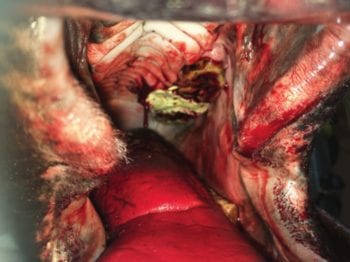
Following on from this, Dr Du Toit described coronectomy as a treatment option for horses with canine tooth resorption; however, she did warn that careful case selection was needed for the technique to be successful. The lectures continued thick and fast; they were kept short in length, but were full of information. At college I was always one of the students at the back of the lecture hall struggling to stay awake; however, here there was no sleeping, as everyone gave the lecturers their full attention. A lecture on retained and displaced teeth concluded these should be removed only if clinical signs, or secondary signs such as periodontal disease, occur. A lecture on bit-induced lesions in the equine mouth reported incidence as high as 58% in a population of 121 horses examined. A bit that was fitted too wide was associated with a higher occurrence of bit-induced lesions.
A session on the frontonasal suture line concluded that its closure happened late in life and, therefore, horses are susceptible to suturitis for most of their lives. Another lecture explored behavioural signs associated with periapical infection of equine cheek teeth. Owners of horses with periapical infection reported signs of aggression and avoidance behaviour were improved after removal of the infected cheek tooth. This suggested these behavioural patterns were associated with dental pain.
Different therapeutic approaches for periodontal disease were discussed. Cleaning and debridement is still the most important treatment option for treating periodontal disease. This may be supplemented with diastema widening, packing of periodontal pockets with calcium hydroxide cement (such as Provicol) or bridging diastema with dental putty. Whichever treatment option is chosen, the take-home message was the key to a successful outcome is regular, frequent visits, initially every few weeks in severe cases.
Another fascinating lecture was how to perform a safe maxillary nerve block and how to deal with complications. This lecture was detailed and proved to be a great refresher of the anatomy of the head in the region of the maxillary nerve block. The major potential complications are haemorrhage (this is best treated with compression), infection (a strict aseptic technique is essential) and dehydration of the cornea due to decreased lacrimation (this is best avoided by the application of corneal lubricant).
The headline presenter on the second day was Travis Henry from the US. He delivered three great lectures. The first was on two techniques he had developed for improving the success rate of per os extraction. Partial coronectomy involves partial removal of the clinical crown of a diseased tooth to the level of the crestal bone to prevent crown interlock.
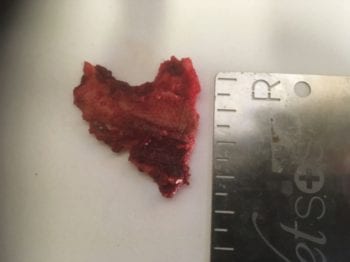
The creation of this 3mm to 4mm space allows less pressure to be applied to the tooth with spreaders and luxators. The second technique, tooth sectioning, can facilitate the extraction of teeth with minimal clinical crown or root abnormalities. In conclusion, Dr Henry warned these techniques could be challenging to learn, and practice on cadaver specimens was recommended. He also advised frequent interoperative examination with a mirror or oroscope, as well as radiography, is vital to guiding the successful completion of these techniques.
The second lecture was on the basic principles of incisor and canine endodontics. Two main endodontic treatment options are available for incisor and canine teeth in horses. These are vital pulp therapy (VPT) and root canal therapy (RCT). VPT treats damaged or exposed pulp in an effort to preserve tooth viability. RCT involves total removal of a non-vital pulp followed by complete obturation and restoration of the tooth. Dr Henry summarised the lecture by saying equine incisors and canine teeth were good candidates for endodontic treatment. However, tooth resorption of any kind is a contraindication to endodontics.
His third and final lecture was on cheek teeth endodontics. Dr Henry stressed this was still not a perfected, straightforward procedure. It is complicated by several factors, including the length of equine pulp horns, challenging access to the more distal pulp horns, uncertain communication between different pulp horns and, most importantly, because the common pulp chamber is situated near the root apex rather than in the occlusal aspect as in dogs. Endodontics is not always a suitable treatment, and in some cases extraction is still the preferred treatment option. Nevertheless, with careful case selection and a compliant owner and horse – and with the procedure carried out over multiple visits – it can be successful.
I have only given you a brief synopsis of the equine lecture stream; however, my small animal colleagues report the lectures in the small animal streams were also excellent. It was not all work and no play, though – we still had time to visit the beautiful city of Utrecht, with its lovely architecture and quaint canals. I managed to visit the castle, the oldest building in Utrecht, which fortuitously also now houses a microbrewery. I combined two more of my passions – history and beer. In 2020, the congress is in Nantes, France, from 4 to 6 June. Put the date in your diary – you will not be disappointed.